Solway Cockle Fishery Management Study
A report summarising the trial of management options in the Scottish Solway cockle fishery
6. Results: The Management Study
After a European-wide invitation to tender six enquiries of interest were received and five full proposals submitted. Following evaluation of the proposalsby Marine Scotland, the contract was awarded to Deefish Ltd. They submitted a high quality proposal which supplied viable approaches to meeting the criteria outlined in the call to tender as well as novel ideas about how the fishery could be managed. Sub-contracting to Deefish Ltd was the Scottish Solway Firth Shellfish Growers Co-operative, who managed the shore-side activity of the contract on behalf of Deefish Ltd. The management study was expected to start in the middle of September 2013 but due to delays in the results from the cockle stock assessment and other administrative procedures the management study started on the 15th of November. It ran for four weeks before it was suspended, due to low meat yields of the cockles harvested. The suspension remained in place until the meat yields improved and the cockles could be sold. In July 2014 the contractor confirmed with MS that meat yields had recovered sufficiently and that a viable market had been identified and that they wished to work through the remaining eight weeks of the contract. The study re-commenced on the 28th of July 2014 and ran for two weeks before the contractor requested to withdraw from the contract due to the inconsistent quality of the cockles and unfavourable market conditions.
These conditions will now be explained before the data that were collected during the second phase is presented and key achievements and limitations of the study outlined. Finally observations of future management will be made.
6.1 Reasons for Suspension
To fully test this management model there was a requirement for a commercial volume of cockles to be gathered and sold via a central distribution centre. Picking commenced in early November 2013 after markets had been secured on the basis of samples sent to buyers in September 2013. Prices had been discussed based on cockles producing a cooked 'yield' of 18%-19% (the ratio of meat to whole weight including shell). 'Yield' describes the percentage return of cooked weight from a batch of uncooked whole cockles. For example, if 10 kg of whole cockles including shells returned a cooked weight of 2 kg of meat then the yield is 20%. This market was for the transportation of live cockles to Spain for the shellfish to be cooked and canned in Spain.
Once fishing commenced in November the cockle yield had dropped to 10%, from 19% in September, which was unacceptable to the buyers for hand gathered cockles, so the produce was refused. Whilst some drop off in yield is expected during the colder months (14% is a normal yield during winter months) 10% is unusually low and could not have been predicted. An additional difficulty within the market was that higher yielding cockles were available from a variety of regions e.g. Spain, Portugal, France and Holland. This combination of low yield and alternative availability made the marketing of Solway cockles difficult and the product could not be sold at a price which covered costs. In addition to this the contractors had identified several beds of large cockles, and secured markets for a small volume to the 'live' market, which after depuration, is where the cockles are sold directly to the consumer and then cooked at home. For this market the size of the cockle in terms of pieces of meat per kg is more important than the yield, but the amounts requested were too small to make the gathering and depuration cost effective and again prices were low. The management model was therefore unable to be tested at volume so the study was suspended.
6.2 Reason for Termination
Given the desire to fully test this model, the contractors were requested to monitor the cockle yields and recommence once better yields were present and new markets sourced. MS were contacted in June 2014 with a proposal put forward by the contractor to cook the cockles in Scotland and sell directly to Spain which would reduce the transportation risks and improve the price for fishers and associated businesses. As the study was interested in different markets, MS were keen to explore this option and the contract was restarted.
After what was a positive start and much work from a range of individuals and businesses the product was graded by the Spanish buyers on arrival and the cockle quality was deemed inconsistent with too much shell left in the product. Whilst this product was processed at an International Food Safety ( IFS) Higher Level accreditation processing facility, the time required to streamline the factory line was limited given the length of the contract and the waste, i.e. edible cockle meat which was 'lost' during processing, reduced the overall yields which was not deemed cost effective even though the overall quality of the meat was high.
In addition, controls on the beach were also proving problematic with some minor infractions having been identified. As discussed in section 2.3 if internal management mechanism are weak a TURF system is unlikely to be successful and whilst these were very early days in the fishery and teething problems are expected, the team did not appear to have the level of cohesion required to implement this type of model. More detail on this breakdown is discussed in section 5.6.6 and the implication for future management outline in section 6.1.2.
Given these significant challenges and the market conditions facing the contractor, Deefish Ltd requested a withdrawal from the contract. Due to the time remaining, the approaching expiry of the AA for the current TAC, and the length of time required to resubmit a call to tender under European procurement rules, MS accepted the withdrawal and terminated the contract. Whilst the early termination was disappointing there were a number of significant achievements and lessons learnt from the formulation of the study, during the set-up period and from analysis of the data collected from the second phase which can feed into the long term management of the Scottish Solway. These are discussed below.
6.3 Health and Safety
Due to the dangers posed to participants in this fishery i.e. working in fast moving tidal areas, the presence of quick sands and shifting sand banks, health and safety is a primary concern. All pickers, if not already certified, were required to attend the four basic fishing training courses required by all commercial fishermen and then further training on a Solway specific course known as the 'Solway Shore Awareness' course, which supplied fishers with training directly related to the estuary. This was a new course designed specifically for the trial by the training manager of the South Scotland Seafish Training Association ( SOSSTA) and was informed by the 'Guidelines for safe working in estuaries and tidal area when harvesting produce such as cockle, mussels and shrimps' produced by the Health and Safety Executive after the 2004 Morecombe Bay tragedy. All fishers attended the full range of courses and 100% of the 46 attendees were awarded the basic four fishing tickets (unless they already had them) and the Solway Shore Awareness ticket.
Following on from this, the Scottish Fishermen's Federation ( SFF) were approached and approved the allocation of free, specially designed, Personnel Floatation Devices ( PFDs) to all fishers involved in the trial and arranged for training on the use, care and maintenance for the PFDs by the Royal National Lifeboat Institution ( RNLI). The RNLI were very keen to endorse sea safety of fishers working in intertidal areas, if local conditions and safety are not adhered to. This training was well delivered and received with 100% attendance and very positive feedback from attendees after the event.
6.3.1 Beach Safety
A number of methods were put in place to promote safety on the beaches during harvesting. The first was the role of supervisors on the beach which was to ensure people's safety, but in this case the supervisors were out on the beach with a team of pickers as an active picker. The supervisors were responsible for up to 20 pickers, for logging their team on and off the beach, informing rescue agencies of their location and cockling activity and monitoring pickers behaviour on the sands. This also included a paper trail which formally logged all activity. After some initial concern around the feasibility of completing the beach-based paperwork when working on the sands (wet hands, cold, windy conditions) the supervisors accurately completed the main beach-based form to the required standard. To increase the transparency and assure that pickers had a record of their activity, individual harvesting receipts for each picker were designed. These were not completed because, it was claimed, pickers were not willing to wait after returning to shore for their receipts. Overall feedback from the key enforcement agencies was thatthe supervisors acted responsibly in monitoring and recording correctly the processes put in place to increase beach safety.
On both harvest sites cocklers walked to the beds which were close to shore with quads and crew cab 4x4s available on the sands for evacuation if needed, but which otherwise were ferrying equipment at the beginning of the day and later cockles. For the length of the study this was sufficient but it is apparent that some system of personnel transport is required for distance beds. This is a service often provided by Gangmasters [3] in other sites in the UK and this is clearly a challenge under the TURF model as sufficient finance needs to be available to support this. It was later stated that the aim of the contractors was to use the first few weeks activity on the near shore beds to finance the purchase of more equipment for the distance beds, but this did not take place due to the early termination of the contract.
During the second phase, access was agreed with a local farmer in an effort to simplify the logistics (movement of cockles and pickers), supply ample parking for cocklers and eliminate disturbance to local residents in the vicinity of the harvesting area. An added benefit of this agreement was the availability of heavy duty, well maintained machinery to work on the shoreline (weighing and loading cockles) which improved the efficiency of the process and reduced the demands on the pickers.
When out on the sands, all cocklers were required to wear a fluorescent bib (different colours for supervisors) and their PFDs. These PFDs were specifically designed for fishermen to minimise any restriction on mobility, therefore all men felt able to comply with a blanket rule of wearing a PFD during any cockle activity. Again it was observed by the enforcement agency that all fishers were suitably equipped with appropriate PFDs, a high-viz waistcoat and other appropriate clothing i.e. warm and waterproof.
Observation - It should be a prerequisite that all hand licences associated with the Solway cockle fishery require completion of the basic four safety courses and the new Solway Shore Awareness course. These should be arranged for the beginning of the season for all new licence holders and refresher courses run as and when required.
Observation - Due to the size of the Solway and the need for specialised equipment with significant up-front costs, a TURF approach - which take a communal approach to resource extract and therefore also to the supply of equipment to facilitate this - would require significant funds to support a group based fishery. Whilst not impossible, this level of up-front investment would require careful consideration and other charging options (levy, licence fees etc) should be considered for future management.
Observation - The benefits of working with commercial farms etc, were apparent during the second phase. Not only do these locations have the space to cater for this type of activity, but also heavy duty machinery is available and well maintained for working on the shoreline. By charging a levy per ton this would enable other businesses to benefit from the cockling activity whilst reducing local disturbance to communities. Interested parties with good access to cockle bed should be approached to explore the feasibility of getting controlled access to all key beds in the region.
6.3.2 Food Safety
The second areas of health and safety were identified as food safety and public health. Shellfish is a high risk food group and since the horse-meat scandal, food traceability has a higher public profile. As part of this study we were keen to work with the Food Standard Agency of Scotland ( FSAS) to simplify the process of classifying and monitoring the cockle harvesting area. This resulted in all cockles beds being classified as category 'B' after analysing the shellfish flesh for E.coli in the area (please see annex 1 for details on this classification) and then weekly monitoring for E.coli and marine biotoxins of the harvested cockles was carried out at the certified distribution centre for the purposes of this study only.
During the establishment of the study, much work was undertaken between the relevant authorities to implement this monitor regime. Annex 1 outlines the method in detail. During the study samples were collected from Deefish Ltd. Unfortunately due to the length of the study we were unable to establish with certainty whether this method is viable for classifying cockles in an open fishery. However feedback was positive and it is believed that this is the approach required to improve traceability and provide more protection to public health.
Observation - Building in capacity to improve and develop food safety should continue with the advancement of this fishery. Given that the demand for better food traceability is only likely to increase, the Solway cockle fishery is in a good position to lead on this with the collaboration of the FSAS and the Local Authority (Dumfries and Galloway Council).
6.4 Composition of Fishing Team involved in the Management Study
Of the 46 fishers who were registered with the Scottish Solway Firth Shellfish Growers Co-operative, 25 pickers completed a questionnaire which was designed to gather data on the social profiles of the fishing team. Due to the two short fishing phases, it was problematic gathering this data from the full team as some members had not returned their questionnaire before fishingwas suspended, therefore these data are partial and should only be viewed as an indication of the social profile of those interested / involved in cockling rather than a definitive study.
The age composition of those surveyed shows that the majority of pickers were 36-55 with a number ofyoung pickers in the age bracket 19-25. The highest proportion of experienced pickers were in the 36-65 year old cohorts and all the younger pickers aged 19-25 and the majority of 26-35 had no past experience at cockle picking (Fig. 4).
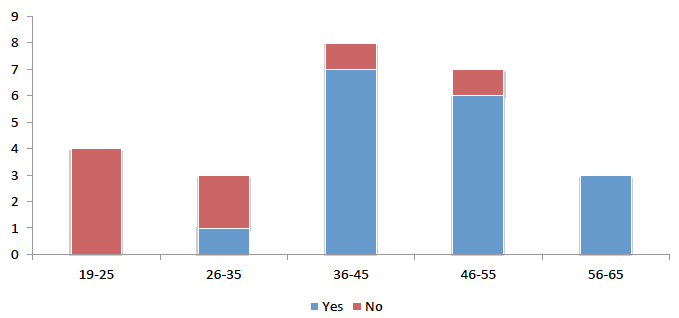
Figure 4: Age composition of surveyed pickers and breakdown of pickers with past cockling experience and those without experience ( n = 25).
Of those who gave data about other cockle fisheries that they had worked in ( n = 10), all had worked in Morecombe Bay in Lancashire and the majority in the Dee estuary in Wales and the Ribble estuary also in Lancashire (Fig. 5). Only the older fishers had experience in the two east coast cockle fisheries, the Wash and the Thames, which in the past had hand collection but are now dominated by boat fisheries (Moore, 1990).
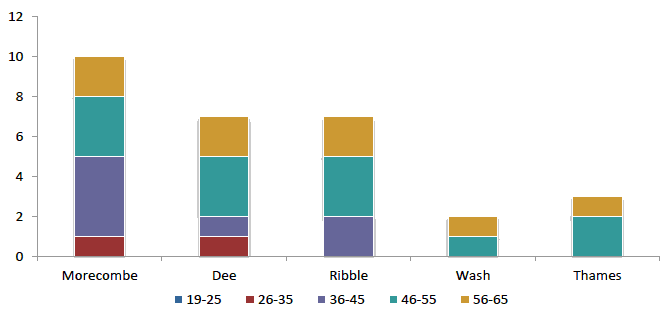
Figure 5: Age profile by other fisheries that pickers had experience of working in ( n = 10).
Of the fishermen who responded, the highest proportion had 11-20 years picking experience followed by those who had none to very limited experience in the 0-2 years cohort (Fig. 6). This indicates that the team was relatively inexperienced with almost half of those surveyed having less than five year experience in cockle picking.
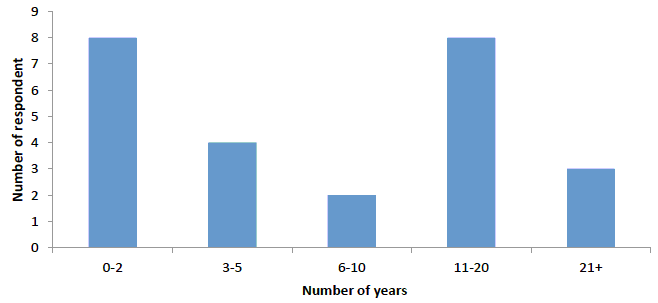
Figure 6: Number of years experience at cockle picking
One of the objectives of this study was to measure the potential local benefits from opening the fishery. Just under half of those who responded, or 11 people stated that this was their only current form of employment (Fig. 7) and for a couple of fishers this was their first opportunity after being long term unemployed. This proportion however should be treated with caution as many surveys were not returned, most likely due to people being unavailable outside of fishing because of other forms of employment.
For those that had other employment this included construction work, fisheries (mussels and lobster), seasonal council contracts and bar management . A number of harvesters hadother qualifications which were either general construction qualifications or a specific trade which included bricklaying, plastering, painting and decoration and roofing.

Figure 7: Number of pickers who stated whether this study was their only current form of employment
6.5 Fishing Activity under the Management Study
Fishing on a commercial scale under the management study took place for 12 days - 6 days in November 2013 and 6 days in August-Sept 2014. Samples of cockles between 200-500 kg were also collected on a number of days around these main fishing dates by 3-4 pickers to measure yields and supply buyers with samples. A total of 32,302 kg of cockles over 25 mm were removed during the study.
The main sub-contractor to Deefish Ltd, the Scottish Solway Firth Shellfish Growers Co-operative, had 46 registered pickers which under the management study had permission to collect cockles. Of thesean average of 22 pickers fished most days, with 30 pickers as the highest attendance and 14 pickers as the lowest.
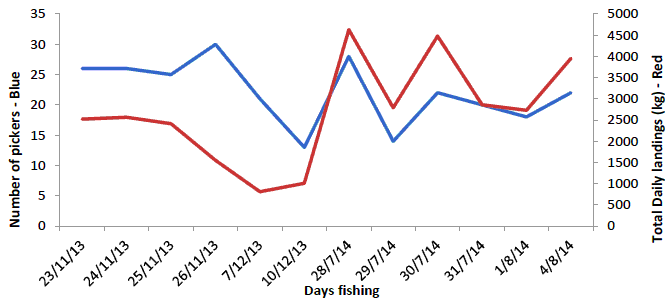
Figure 8: Number of pickers (blue) and total daily landings (red) on each main fishing day
As demonstrated in figure 8 efficiency in the collection of cockles per picker in the first period was low, with daily harvest ranging from 810 kg to 2,560 kg, whereas this improved in the second period where kilograms landed increased significantly, to between 2,787 kg to 4,630 kg, per day whilst the number of pickers was slightly less during this period - average 23 pickers in the first period and 21 pickers in the second period.
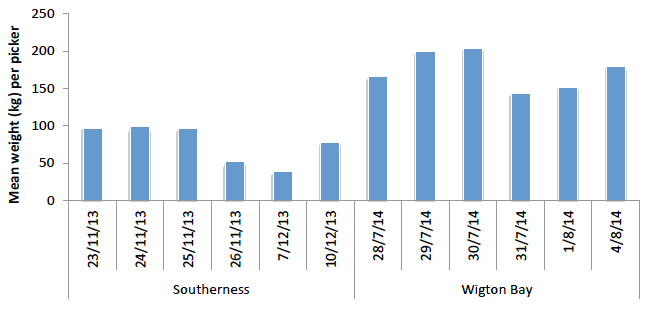
Figure 9: Mean weight per picker per fishing day.
This is further demonstratedin figure 9 which shows the average collection rate per picker with collection at Southerness, at 78 kg per day per picker, much lower than at Wigton Bay at 159 kg per day per picker. This is most likely due to the experience of the picking teams - a number of highly experienced and well equipped pickers came onto the team at Wigton Bay, but also due to the density of the cockles at Wigton Bay and improved logistics - good access point close to the harvesting area.
As harvest rates varied substantially between pickers, the data which was collected during the second phase, was analysed in detail. To capture the variation in picking rates the data was grouped into thirds and analysis conducted on picking teams and then on individual pickers. In the lowest performing third an average of 5 bags per tide were collected per team with an average weight per tide of 205 kg. This increased to 10.8 bags with an average weight of 351 kg per tide per team as the mean and the highest performing third had picking rates of 13.3 bags and an average weight of 590 kg per team. This resulted in the lowest third having picking rates of 106 kg per person, the mean182.4 kg and the highest third 305 kg per person per tide [4] (Table 2).
Table 2: Data based on the six tides picking in August 2014 (data from the second phase only)
| per picker |
||||
|---|---|---|---|---|
| Lowest third |
Middle third |
Highest third |
Mean |
|
| Mean number bags per tide per team |
5.0 |
7.0 |
13.3 |
10.8 |
| Mean weight (kg) per tide per team |
205.0 |
298.7 |
589.8 |
351.0 |
| Mean number bags per tide per picker |
2.6 |
3.7 |
6.9 |
5.6 |
| Mean weight (kg) per tide per picker |
105.6 |
156.8 |
305.1 |
182.4 |
| Mean weight (kg) per bag |
30.6 |
33.7 |
34.3 |
32.5 |
| SD weight per bag |
29.7 |
34.8 |
32.4 |
6.8 |
The lower picking rates were associated with new, inexperienced pickers who had yet to develop the technique and fitness levels required to harvest cockle at the higher rates. These rate are however comparable to other fisheries in the UK were the Dee cockle fishery limited daily harvests to 150 kg in 2013 down from 300 kg in 2012. This lower rate in the Dee was put in place to protect stocks whilst accommodating all current licence holders, however this is far from ideal due to the high level of inefficiency and rent dissipation between a high number of pickers for the available resource.
To understand potential earning per picker the rate that fishermen were paid during the Solway cockle study which was £0.80 per kg (£1.15 - £0.35 costs = £0.80p per kg) were used to establish average earning per group. The average earning per tide per picker was £84.80 for the lowest performing third, £151.20 for the mean and £244 for the highest performing third. Figure 10 indicate potential harvest rates and earnings that pickers could take depending on the length of the season. So assuming 20 tides per month, fishing incomes would range from £3,024 after costs (3,650 kg) for the mean picker at £1.15 per kg and up to £4,880 after costs (6,100 kg) at the highest picking rate per month.
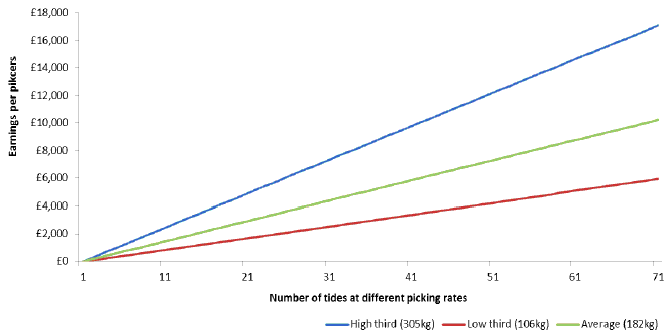
Figure 10: Potential earning and the number of tides required at different picking rates
Whilst this work is seasonal [5] and income would only be obtainable for the months that the fishery was open, to put this in some context table 3 describes hourly, month and annual earning at these rates and compared them to the minimum and living wages for the UK.
Table 3: Based on an 8 hour day and 20 working days (tides) per month
| Minimum wage |
Living wage |
Low harvest rate |
Mean harvest rate |
High harvest rate |
|
|---|---|---|---|---|---|
| Hours |
£6.50 |
£7.65 |
£10.60 |
£18.90 |
£30.50 |
| Monthly |
£1,040 |
£1,224 |
£1,696 |
£3,024 |
£4,880 |
| Annual |
£12,480 |
£14,688 |
£20,352 |
£36,288 |
£58,560 |
This is based on relatively moderate earnings per kg, which was paid during the study, and as will be described in section 5.7 the price paid per kg fluctuates greatly so the opportunity to earn higher wages per tide is likely.
Observation - Future management of the Solway cockle fishery should offer the opportunities for young inexperienced fishers to enter and benefit from the local resource. This could be achieved through apprenticeship schemes, however fishing opportunity needs to be monitored to ensure that new entrants have the chance to work in the fishery once the apprenticeship is completed.
Observation - Due to the seasonal nature of this fishery, opportunity should be made available for fishers who work in other fisheries (e.g. creeling) but who may wish to diversify and supplement their main fishing activity with cockling. This could be offered through a limited number of annual licences that become available once the TAC for that year fishery is known and allocation for long-term licence holders* is assessed and met. This should not affect the rights of fishers who wish to apply for a long-term licence.
*Conditions and terms surrounding any long-term licence will need to be defined and should not assumed to function as an assets or to be tradable/transferable by licensees.
6.6 Compliance and Enforcement
Enforcement is problematic in the Scottish Solway due to the size of the estuary and an abundance of isolated entrance and exit points onto the sands alongthe coast. Because of the financial rewards and potentially low barriers to entry, cockling is an attractive activity which in the past has attracted people from far and wide. There is substantial anecdotal evidence to suggest that uncontrolled access in the past has resulted in direct financial costs and social disturbance for affected communities in Dumfries and Galloway, for example as a result of littering, damage to property and disruption to public services i.e. local bus and school runs, which has created a negative legacy which any future management of the Solway cockle fishing needs to take into account.
To start addressing this, a key achievement under this study was the establishment of a multi-agency enforcement working group to take an integrated approach for dealing with non-compliance and enforcement. Through this working group, past and present problems with the fishery were discussed, and viable solutions proposed and debated between the enforcement group. Agencies involved in this working group included: Marine Scotland Compliance, Police Scotland, the Gangmasters Licencing Authority ( GLA), Food Standard Agency Scotland ( FSAS), Dumfries and Galloway Council and Scottish Natural Heritage. Non-enforcement members were Marine Scotland Science, Solway Firth Partnership, South West Inshore Fisheries Group, and the Maritime & Coast Guard Agency. Invitations were also extended to the NW-IFCA who were keen to support the group but unable to attend meetings during the study.
In addition to the general discussions on past and present problems in the Solway, good practice from other UK and European cockle fishery and suggestions from the contractors application were discussed and integrated to devise a viable enforcement plan. Those related to the management study are now discussed.
6.6.1 Reporting to Enforcement Officers on Daily Fishing Activity
A weekly harvest plan was sent on the Friday before fishing commenced detailing the forthcoming week. This informed all enforcement agencies about the location and composition of daily fishing activity and meant that any non-notified activity could immediately be identified as non-compliant / illegal. Daily notifications were then emailed on the morning of fishing to confirm start times and the number of pickers on the beach. These emails (example below) would be sent to a central email account and then forwarded to all enforcement agencies, ensuring all were aware of the location and size of the fishing team operating under the study.
Example of notification:
Date of Harvest - 10/12/2013
Point of Access - Southerness Lighthouse
Point of Egress - Southerness Lighthouse
Time on - 7:30
Time off - 12 noon
Shore Manager - AA
Supervisors - AA, BB, CC
30 fishers on the beach
Initially emails listed the actual ID numbers of the fishers on the beach but this was revised to the number of fishers, due to the difficulty of obtaining this information with the required accuracy. A second issue arose when the start times were in advance of the email received - before the administration office was open - however retrospective email alerts were sufficient to state egress times which was suitable for compliance inspections. This reporting process allowed Marine Scotland Compliance to build and test a distribution list with various agencies as well as local fishery officers. A further safety requirement was to call the Liverpool coastguard to inform them of pickers being on the beach. To begin with there was some prompting required for the supervisor to call the coastguard, but that soon became a matter of routine, as did notification when fishers returned to shore. Overall the process worked well and it was reported as not too arduous for the contractors.
6.6.2 Identifiable Teams
All fishers were required to wear coloured bibs, with the supervisors in a different colour to make the teams easily identifiable to compliance officers and local residents. The benefits of this were clearly demonstrated when a member of the public rang MS to report what they perceived as illegal fishing activity and were able to report with ease the number of fishers, their location and time on which was crossed referenced with the daily email and they were confirmed to be the fishing team working under the study.
All harvesters were required to carry identification cards with them at all times which demonstrated that they were permitted and qualified fishers. The documentation was easily recognisable as belonging to the study and hard to imitate as they were produced by a professional card company. In addition, as in the Bury Inlet cockle fishery, registration numbers of all vehicles involved in the study were supplied to all enforcement agencies. This increased the agencies' ability to regulate access in the area and monitor the transportation of legal cockles under the study and therefore to identifyillegal cockles gathered external to the study.
Under the management study, cockles were transported from the beach in pre-approved coloured bags. As in most UK cockle fisheries, the bags were designed based upon the weight they can hold (i.e. 30 kg bag) with the pickers ID number attached to each bag. This allowed close monitoring of the catch being taken by picking teams, which enabled: 1) individual fishers to be warned if the product was not to the desired quality; 2) the protection of the stocks by monitoring the removal of undersized fish; 3) improved compliance with fishing regulations and; 4) allowed the fair and transparent payment of harvesters. During both fishing periods, bags were monitored and in the second period a number of smaller cockles were detected in the catch. This was fed back to the fishing teams and corrective action was taken to grade the animals more closely. Unfortunately fishing was terminated before improvements were verified.
6.6.3 Documentation for Compliance Officers
To improve enforcement and establish processes to improve the traceability of the seafood, tailored documents were produced and approved by the enforcement group. For data collection and record keepingat the shore 'Daily Harvest' sheets ( annex 2) were completed by the supervisors prior to work commencing and then after fishing had ceased to record all activity that has taken place during that day. This sheet was developed by Marine Scotland and the contractors and training was undertaken with all supervisors and the staff at the central distribution centre. Feedback was taken after the first few day's fishing to check the ease of the process. It was pointed out that the sheets were likely to get wet and muddy and therefore it was best to complete the first stage whilst at the car, then take notes in small note books whilst on the sands to complete the final section when back at the car after the work was completed.
A second document was designed to increase transparency and in response to reports of unfair treatment of pickers in the past. This was a duplicate book ( annex 3) for supervisors to distribute receipts for bags landed at the shore side so all pickers had a record of their activity should dispute arise at a later date. It was however stated that tired, cold fishers are not very keen to wait around once finished for paperwork, therefore these books were rarely completed and receipts were not given. The third form was the 'Beach Movement' sheet which accompanied the cockles from the beach to the distribution centre. This sheet ( annex 4) detailed the composition of the catch being transported from the beach, so should a vehicle get stopped it would be easy for an enforcement officer to check that all the catch in the vehicle was correct and accounted for.
Every attempt was made by the supervisors to ensure that the main documentation described in the TURF process was adhered to (with the exception of the receipt books) and all documents leading from the beach to the final movement document covering transportation to the distribution centre were completed accordingly.
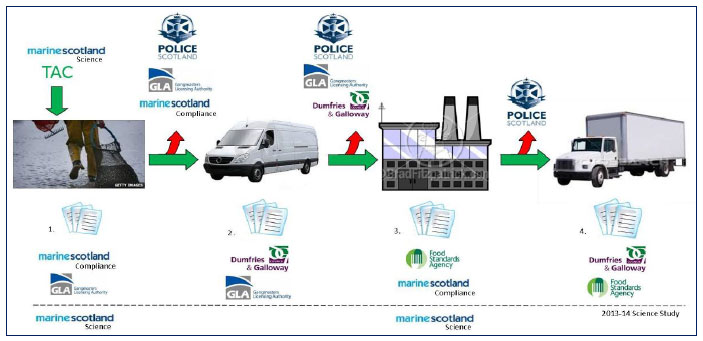
Figure 11: Diagram of the business model and responsible agencies for a fully documented fishery. Green arrows are the legal movement of cockles, red arrows are the illegal movement of cockle and the responsible enforcement agency.
On arrival at the distribution centre an intake sheet ( annex 5) recorded the arrival time, the conditions (e.g. temperature) and quality of the cockle. This was linked to the other documentation so each batch of cockles could be accurately tracked in the distribution centre. This was completed accordingly by the distribution staff and all other data collection required under the study was undertaken after this paper trail was completed.
Observation - Any future fishery in the Solway should have a fully documented processwhich can track bags of cockles back to the picker and the beach area, all the way through the chain to the final customer. The paperwork produced during the study is fit for this purpose and should be used as a template and refined as and when required. What is key is that the process should be as streamlined and straightforward as possible to facilitate compliance.
6.6.4 Centralised Distribution Centre
Deefish Ltd supplied the premises which acted as the central distribution centre for the study in Kirkcudbright. The facility is audited to SALSA (Safe and Local Supplier Approval) standard and outside of the study was a primary processing factory for queen scallops. The facility is fully certified for the primary processing of seafood and also had a temporary packing licence for cooked produce.
The distribution centre had two main duties, the first was to intake all cockles collected under the management study for audit and quality control. This involved the unloading and appropriate storage of the cockles, as well as data collection for the study. The second was to support the FSAS and follow protocols to test the new methods for food classification. The centre under Deefish Ltd also managed the sales and marketing element of the contract, which involved sourcing viable markets for cockles and negotiating with buyers who wished to purchase cockles as well as administering all payments received andprocessing all payments to the sub-contractor, the Scottish Solway Firth Shellfish Growers Co-operative.
Beyond these tasks, a key objective in having this central distribution centre was for improved compliance and enforcement. As the selling of cockles on the beach was prohibited, all catches went through the centre which facilitated the transparent monitoring of catch, and mitigated almost all of the social problems attached to the open-access regime of the past (for example the blocking of public roads by large volumes of buyers and pickers and the anti-social behaviour associated with groups conducting business transactions at the shore). Fishery Officers and other enforcement agencies were able to conduct inspections of landings at the distribution centre and check all records which gave assurance of quantities harvested and the quality and health of the product going into the food chain. As all paperwork associated with the fishery was held in one location, enforcement agencies had a single point of call and ready access to anything they needed. This was especially important for Environmental Health and the FSAS.
Observation - A central distribution centre offers many benefits for improved compliance through auditing as well as for the development of improved food traceability and should remain an important consideration for future management.
This should not necessarily be limited to one centre and the future fishery may consist of more should a viable case be made for multiple centres.
6.6.5 Rules violations
Clear rules were established at the beginning of the study. All fishers signed an agreement to abide by these rules and all supervisors were aware of their specific responsibilities as pickers and team leaders. In the first phase no internal violations of the rules were brought to the attention of compliance officers and all enforcement agencies commended the behaviour of all of the fishing teams. During the second phase some minor infractions were brought to the attention of fisheries officers, the first by a member of the public who contacted Marine Scotland directly and the second was an internal report on unlicensed activity. Due to the termination of the study neither of these violations were taken further butthey demonstrate the need for clear rules on the sands to manage behaviour.
6.6.6 Policing of Unlicensed (illegal) Fishing
During the study compliance officers and the police patrolled various areas know to be used by unlicensed cockle pickers, however, no signs of poaching were present. In one case some harvesting paraphernalia was discovered and retained but the local view was that the yields and near shore stock densities did not warrant any illegal activity. Therefore new powers available to fisheries officers have, to date, not been tested [6] .
One approach that the enforcement working group would like to develop further involves the seizing of cockles which lack appropriate paperwork. Currently due to the cost and logistics in handling cockles which once they leave the beach are considered to be a food product, compliance officers are less inclined to seize cockles without considerable proof that they have been obtained illegally. However this would be less problematic if a facility was available to store and process the cockles so they can be classified by Environmental Health and transferred into the food chain. Cockles could therefore be seized and held for a short period of time or sold and the money retained whilst the persons who the cockles were seized from had the opportunity to prove their legality. Currently this system is a complex process but much has been achieved in moving this closer to reality and a central distribution centre of some sort would be key in making this a viable option of policing illegal activity.
6.7 Transparency and Fairness
A key objective of this study was to investigate how this fishery could be managed for improved transparency and fairness to the individuals who contribute the most, the cockle pickers. Past reports (The Guardian, 2011; Marine Scotland, 2012) have detailed cases where fishers have been disadvantaged and mispaid i.e. not paid the agreed rate or not being advised of the rate of pay in a timely manner, therefore we were keen to understand this further and build in procedures that eliminate this practice.
Data from the social questionnaire showed that of those who have harvested cockles in the past the majority were informed on their rate of pay per kg after they had landed their catch or on the morning before picking commenced. A few were informed the week before and in one case at the end of a set of tides (Fig. 12). Within the management study, the aim was for pickers to be informed by the primary contractor at the beginning of week of thenet price per kg which they would receive. Thepickers then were able to make an informed decision as to whether to fish or not. This was achieved for the study and all fishers were informed of the rate at the beginning of the week which was £1.35 per kg less a £0.35 per kg levy during the first fishing phase and then £1.15 per kg less a £0.35 per kg levy in the first week of the second period. During the final days of the study, Deefish Ltd informed the subcontractor (SSFMPC) that the available rate had decreased to £0.70 per kg less a £0.35 per kg levy. The harvestteams indicated that they were unwilling to work for that rate. This was indeed their prerogative and this system allowed the fishers to take this action should they wish.
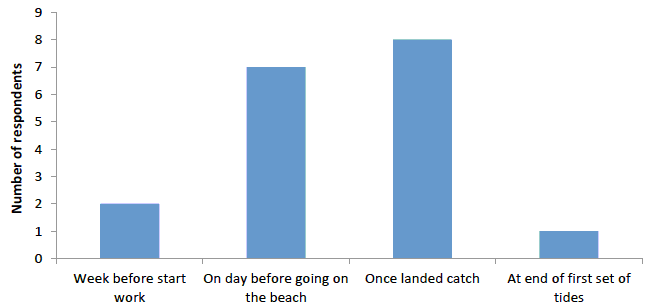
Figure 12: Responses to 'when do you know what rate you will earn from cockle collection?"
Data from the questionnaire showed that in the past the majority of fishers had received £0.60 as a minimum pay per kg and £2.00 as a maximum pay per kg, but that some had received pay as low as £0.20 and as high as £2.40 (Table 4). Under the study a rate of pay of £0.80 after expenses was on the lower side, but as demonstrated in section 5.5 can still deliver a good weekly wage if picking rates are high and tides and other conditions are favourable.
Table 4: Minimum and maximum rates of past pay from respondents
| Minimum (£) |
n |
Maximum (£) |
n |
|---|---|---|---|
| <0.2 |
4 |
1.2 |
2 |
| 0.3 |
1 |
1.5 |
1 |
| 0.4 |
1 |
1.6 |
1 |
| 0.5 |
1 |
1.8 |
2 |
| 0.6 |
5 |
2 |
7 |
| 0.7 |
1 |
2.2 |
1 |
| 0.9 |
2 |
2.4 |
1 |
When asked about a minimum monthly wage pickers would need to earn for the activity to be a viable option, the majority of respondents stated that £2,000 per month would be required (Fig 13). This rose to £3,600 for two pickers and was as low as £300 for one picker who was alternating this form of fishing with creel fishing. As detailed in table 3 in section 5.5, even at the lower rate paid (£0.80) during the study, £2,000 would be achieved at a mean picking rate within 14 tides.
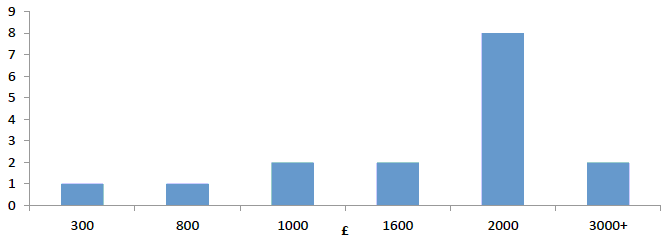
Figure 13: Minimum monthly wage required to make cockling a viable option
To understand what fishers felt would be a fair contribution toward supporting a cockle fishery, they were asked what rate/levy would they be willing to pay to support management.
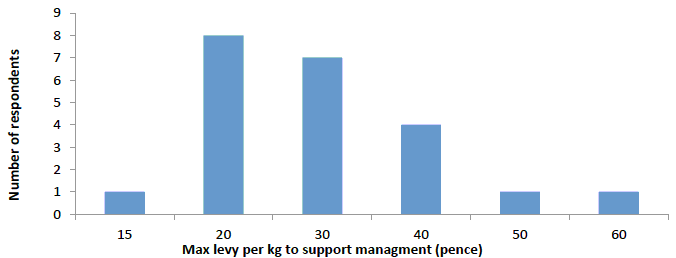
Figure 14: Maximum levy pence per kg that pickers felt should be paid to support the fishery
The majority who responded stated that £0.20 per kg was a suitable contribution with the second largest respondent group saying £0.30 per kg. This rate went as a low as £0.15 and in one case as high as £0.60 per kg, but clearly a rate between £0.20-0.40 was considered most suitable. It is worth noting that the pickers, the levy on the study was 35p per kg and the majority were still willing to fish. In the second phase a number of self-equipped fishers came onto the team, and they felt their levy should be renegotiated given that they were not using the contractor's equipment but using their own. This is clearly a challenge within a communal system such as TURF regime and therefore a multi-levelled levy system maybe more appropriate given the unequal resources that different fishers bring to the fishery.
Observation - To inform pickers in advance of the rate per kg is desirable and should be an aspiration for this fishery however because this was trialled over a very short period of time, it is not recommended at this time and other fair payment systems should be explored. What is important is that transparent transactions take place so that picker know they are being suitable rewarded for their efforts.
Observation - The funding of the fishery should be explored further as whilst a flat-rate levy upon each individual's harvest is a viable option along with licence fees or annual membership fees, how this fund is used and re-distributed will require development.
Data on the financial set-up undertaken by Deefish Ltd showed that after costs the fishery was profitable, with profits of £40.60 per tonne. As table 5 demonstrate the bulk of the expenses were in pickers' wages, followed by transport and then processing. The transportation of the cockles was an influencing factor on profit margins as any shipments under 10 tonnes were reported by Deefish Ltd as costing £0.70 per kg, whilst shipment over 10 tonnes would be able to go in a single container and therefore decrease in price down to £0.15 per kg. The shipments made during this study were all under 10 tonnes which resulted in relativity high costs - around 11%.
Table 5: Details of the expenses and income from the management study
| Expenses |
Detail |
One offexpenses/ income |
Per tonne |
% expenses/ income |
| Set-up costs |
Training, printing and packaging, insurance, safety equipment and licences |
£14,431.93 |
31% |
|
| Transportationand handling of cockles |
Access, transportationfrom beach and to customers, levy |
£157.21 |
11% |
|
| Miscellaneous |
Quad bike repairs, expenses (fuel) |
£52.06 |
4% |
|
| Wages |
Pickers wages minusexpenses |
£670.47 |
46% |
|
| Processing |
Cooking and onshore labour |
£130.31 |
9% |
|
| Total |
£1,010.05 |
100% |
||
| Income |
||||
| Non-sales* |
Memberships and grants |
£10,130.00 |
23% |
|
| Sales |
Sold cockles |
£1,050.65 |
77% |
|
| Profits |
Income minus expenses |
-£4,301.93 |
£40.60 |
The start-up cost were calculated separately as on-off costs for the operation of the fishery as this was funded through a different route. As described in the tender Deefish Ltd worked with a co-operative of cockle pickers which was a separate organisation. To fund the establishment of the co-operative, pickers were charged a membership fee of £500 which was to fund the administrative set-up of the fishing teams and supply training for all pickers. This is not uncommon as most cockle fisheries charge user fees and cost range from £300-£500 for hand picking. In this case, the £500 was initially taken (from the majority of pickers) and then £260 refunded to all pickers who had paid once the final costs and earnings had been calculated. Net revenue after the refund totalled £10,130. This also included a small grant but not all fees as a small number of pickers did not pay the initial fee. The fees collected from licence holders were insufficient to cover all of the one-off set-up costs of £14,431.93, falling short by £4,301.93. This deficit was offset during the course of the fishery by the profits on sales of cockles and by Deefish Ltd'sproportion of the levy which was not collected for the last weeks activity.
When asked for their views on licence conditions, the majority of fishers who responded said that all pickers should have the basic fishing qualification as well as the Solway specific training and that they should sign up to the specific rules governing this fishery. A few respondents felt that no condition should be attached to the licence. The majority felt that as the ultimate penalty for the violation of rules fishers should loss their licence but there was a variance of views over the conditions leading up to that lose of a licence with a number quoting warnings or 'three strikes and you're out' up to instant disqualification at one violation.
Views were divided on daily limits per picker with many saying there should be no limits, whilst othersfelt limits would be acceptable as long as the allocation was financially rewarding. A few felt that limits shouldbe dependent on TAC and length of season. All pickers agreed with a minimum landing size ( MLS) and a number noted that only shellfish over 20 mm should be harvested, whilst other cited high MLS at 25-28 mm.
Finally all fishers agreed that there should be licence limitations for the Scottish Solway with most fishers stated that between 20-50 would be optimal with 30-40 being the most commonly mentioned number.
6.8 Markets
A key challenge facing this study was securing profitable and reliable routes to market. Cockle selling is well-established through networks in the UK which involves a number of middle agentswho have considerable control over the market. Anecdotal evidence suggests that these networksuse this control to secure favourable conditions and in some cases block routes to markets for new businesses wishing to enter the sector.
During the period of this study a number of overseas customers were sourced directly by Deefish Ltd for live cockles and, later, cockles that had been processed in Scotland with the benefits of securing better prices. These customers were sourced directly which navigated around the established UK networks. This approach required time and a high quality product; the latter was the main factor lacking in the first phase of fishing when the yields went down to 9%. Quality again became an issue when a solid market was secured for the second phase, but rather than the quality of the cockles this was due to the underdeveloped cooking process in Scotland and time did not allow this process to be improved before the contract was terminated.
Marine Scotland were informed a number of times during the study by observers of the fishery that marketing opportunities exist for cockles throughout the year, yet because local markets and pre-existing sales networks proved unwilling to engage with the study participants, Deefish focused on trying to find foreign markets. These foreign markets demanded a relatively high quality product, but this became problematic during the trial given the unusually low cockle yields in November, the under-developed processing capacity in the following June and the stop - start nature of the contract which affected the flow of fish. Feedback from the contractor was that whilst there was limited ability to sell to domestic markets at this time, this had little influence on the study as the foreign markets offered good, reliable buyers who are very keen to engage with a well-managed fishery, but more time was required to develop a quality product than was offered during the management study, given the need to suspend the study in November 2013 due to the low yields.
Observation - As the management plan for the fishery develops, markets need to be kept in mind, but efforts should focus on harvesting cockle (within the TAC) in their peak condition and at a volumeand rate that is appealing to a range of different markets. This requires attention to be given to the number of permanent and temporary licences on offer and whether vessels should be involved if the annual TACs support their inclusion.
Whilst beyond the scope of this study, how value-added processes and markets can be developed in the local area should be explored for the development of this fishery.
6.9 Awareness Raising
Media: The study generated a lot of interest from local communities and the local and national media. This included interviews by: the Solway Firth Partnership with Border TV and BBC Radio Scotland; an interview by the Cabinet Secretary for Rural Affairs and the Environment Richard Lochhead with ITV Borders; articles were published on the BBC website and fishnewseu.com and; two local publications were produced by Solway Firth Partnership - a four-page leaflet and a two-page spread in Tidelines, a bi-annual publication. BBC Scotland were also interested in doing a short film on the shore with the fishers however this was delayed and then declined due to the suspension of the study. Local media also reported on the suspension of the study following a press release from Marine Scotland.
Local Communities: The main method for communicating with local communities was a four page cockle leaflet. Hard copies were disseminated to local council offices, community centres, conservation offices and local coastal towns and villages to inform people of the study. Overall this was well received, it was reported that villagers were happy that they were being considered and included and that responding to their concerns given past episodes of anti-social activity related to the fishery was central to this management study. In some villages leaflets were posted door-to-door and copies laminated and displayed on notice boards. Some communities still have concerns and written communications were received from specific communities along the coast.
The Solway Firth Partnership approached local conservation organisations to keep them informed of the study. General feedback was that they were pleased to have been contacted direct which has not happened previously and most were very supportive on the aims of the study. These meetings also functioned as an opportunity to understand conservation organisations' views on the fishery and it became apparent that there were a number of needs that they have which are yet to be properly addressed. Key points which came out of these initial discussions were:
1. Sensitive habitat mapping is needed along the shoreline especially around access points.
2. Documentation ofsensitive periods for wildlife e.g. goose roost and locations mapped would be useful to input into a fishery harvest plan.
3. Identification training for fishermen on sensitive plant species e.g. zostera (seagrass) and habitat is required and was offered by the National Trust of Scotland.
4. An opportunity should be made for knowledge exchange between conservation groups and fishermen to understand each other needs and mitigate potential conflict from a fishery.
5. Conservation groups should be informedon what legal fishing activity looks like so enforcement teams are notified about illegal activity rather than licenced activity.
Just prior to fishing, the contractors met with the National Trust for Scotland ( NTS) to discuss a number of concerns, which included access to the beds and vehicles access. A range of solutions were found should the fishing teams need to access through NTS grounds which assured the NTS but also allowed the fishing team to work effectively.
Taking a direct approach of engaging with conservation groups has been positive and there would be benefits to establishing a conservation group for achieving a sustainable fishery. Key members of this group could include; Marine Scotland Science, Solway Firth Partnership, Scottish Natural Heritage, National Trust for Scotland, Royal Society for the Protection of Birds, Scottish Wildlife Trust and Wildfowl and Wetland Trust to name a few, who help address key areas of concern for wildlife protection and habitat conservation when the need arises.
Observation - A conservation working group should be established to addressing some of the information gaps identified in this section and support the development of a low impact fishery.
Contact
There is a problem
Thanks for your feedback